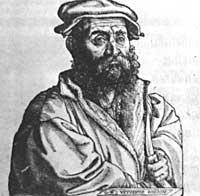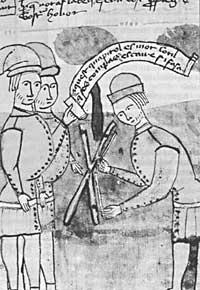Tartaglia
1991/02/01 Azkune Mendia, Iñaki - Elhuyar Fundazioa Iturria: Elhuyar aldizkaria
The real name of Tartaglia was Niccolo Fontana. Italian mathematician born in Brescia in 1499. In 1512, French troops conquered Brescia and a soldier in attack broke his jaw and palate with swords. Consequently, he had difficulty speaking and was called Tartaglia (tartaglia). (It must be clarified that in Italy for centuries an advanced society developed that was totally impoverished with the incorporation of foreign armies).
Tartaglia, however, had nothing to think about (and especially mathematically). Therefore, he taught mathematics at several universities in northern Italy and from 1534 in Venice.

Tartaglia found a solution of cubic equations in the form of x 3 + px 2 = n, equation that does not have the term x. In 1533 he discussed this discovery with mathematician Antonio Maria Fior. Fior was a pupil of the mathematics professor of Bologna (Scipione del Ferro). Del Ferro found a solution of cubic equations x 3 + mx + n = 0 (equation that did not have the term x 2), but the master hid his discovery. But before he died, Fior learned about the solution.
When Fior discovered that he had a solution, Tartaglia tried on her own and found her alone winning the challenge she had with Fior. Although Tartaglia hid his discovery.
In 1537, he had already completed the book Nova Scientia and published it. It was an Artileria treaty, an important pioneering work in the resolution of the laws of falling bodies. It was the first published book on the theory of Ballistics, since although previously Leonardo da Vinci had done another, it was not published.
According to Tartaglia, the projectile initially came out through the mouth of the cannon with “violent movement” and at the end of its journey it fell through the “natural movement”. Between these two phases there was a “mixed movement” zone. The truth is that Galileo, a century later, laid the solid foundations of ballistics apart from this theory.
When it was published, Girolamo Cardano, professor of physics based in Milano, asked him to publish the system of solving cubic equations. Tartaglia refused at first, but then, hoping to be a wool advisor to the Spanish army, let Cardano know the resolution of the equations with the promise to keep secret.
However, in 1545, Cardano published in his book Artis magnae (Major Arts) a resolution. For his part, Tartaglia, in his book Quesiti et inventioni diverse (Some Problems and Invention), broke the secret he faced in 1546, and later had an exchange of letters with Ludovico Ferrari, disciple of, defending his position. His clash ended in 1548 with a public debate in which Ferrari won.
Tartaglia left her teaching post in Brescia to return to Venice. His best-known work is Trattato di numeri et misure. This encyclopedia, which collects basic mathematics, was published in three volumes between 1556 and 1560.
Tartaglia also translated and published works by Euklides and Archimedes.
Tartaglia died in Venice on 13 December 1557.

Gai honi buruzko eduki gehiago
Elhuyarrek garatutako teknologia




